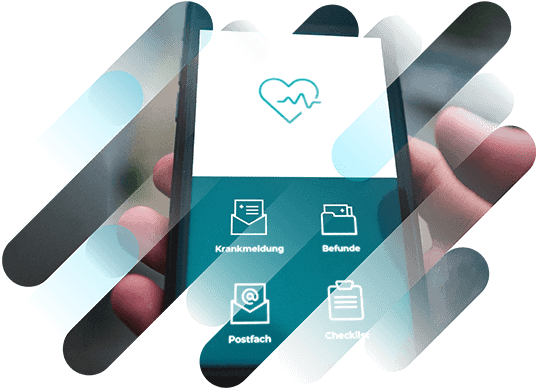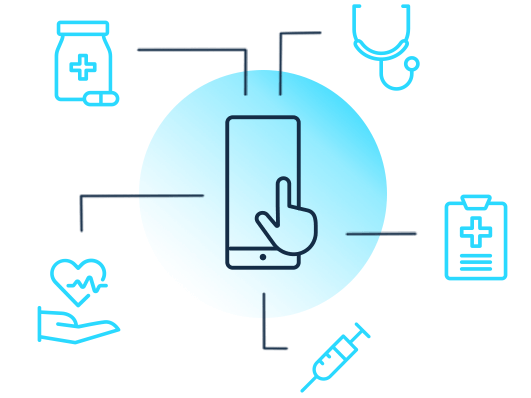Our WAF has a new user interface – for more intuitive and efficient use. Learn more
Home>
E-prescription
01
A definition of e-prescription
Approximately 500 million prescriptions are written every year in the Federal Republic of Germany. Yet the days of the classic prescription on paper are numbered: With the introduction of the electronic prescription (e-prescription), the printed form 16 template’s days are numbered for people with statutory health insurance as early as the middle of 2021. Even though prescriptions will only be available in a digital format in the near future, they will still have the status of a legal document. Plans are in place for privately insured persons to be able to get and fill e-prescriptions in the future. In addition, other prescription forms will be digitized, including prescriptions for narcotics, T-prescriptions (special prescriptions for certain active ingredients), Digital Health Applications Ordinance (DiGA), and green prescriptions. The e-prescription is only one component of the very comprehensive digitalization initiative of the German government.
The “telematics infrastructure” (TI) networks all stakeholders in the health care system and ensures the secure exchange of information across sectors and systems. It is a closed network that only registered users (individuals or institutions) with an electronic health professional card and practice ID can access.
The law, which now also allows medical prescriptions to be written and filled online, has been in force since October 20, 2020. Unlike the tried and tested paper-based prescription, e-prescriptions have additional digital applications: These include useful functions such as medication reminders or medication plans with built-in interaction checks. This ensures that there are no undesirable interactions when taking several medicines.
03
How does the e-prescription work?
As with the introduction of most digital processes, the idea behind the e-prescription is to make life easier for everyone involved.
Step 1 – Writing the prescription in the doctor’s office
On the doctor’s side, the prescription is written in their practice, as usual, using prescription software. The e-prescription is then signed using the electronic health professional card and sent off – ideally with only two clicks. Like conventional paper prescriptions, e-prescriptions must also be signed – with a “qualified electronic signature” (QES). The security level of such a QES is very high: doctors and psychotherapists not only have to insert the electronic health professional card (eHBA) into a reader but enter a PIN as well. After being signed, the e-prescription is transmitted in encrypted form to the e-prescription service in the telematics infrastructure. It is available there for up to 100 days after the prescription has been filled. This is the end of the process for the doctor.
Step 2 – From the doctor to the insured person
The insured person can access the e-prescription using a token. He or she then has the choice of either having the electronic prescription displayed digitally in the gematik e-prescription app or having the token printed out as a data matrix code. Instead of printing out a prescription, the insured person can use the digital code in the e-prescription app to electronically check the availability of prescribed medications at up to three (online) pharmacies in advance.
Step 3 – Filling the prescription at a pharmacy
Then it’s business as usual. The e-prescription must be filled at an (online) pharmacy in Germany. The token is digitally assigned to the pharmacy of choice. Any pharmacy can scan the printed data matrix code on site using a scanner, have the prescription information from the telematics infrastructure displayed, and then transfer it directly to the ERP system.
As soon as the availability of a medication is requested, the selected pharmacy is shown all the prescription information needed to check stock levels. The requests can be viewed and answered directly in the ERP system.
After the prescription is filled, a receipt signed by the e-prescription service is issued, which the pharmacy can use to bill the health insurance company.
Want to learn more about our solutions, use cases and best practices for attack defense? In our download area you will find product sheets, fact sheets, white papers and case studies.
About the author
Stefan Bordel
Senior Editor
About the author
Stefan Bordel has been working as an editor and technical writer at Myra Security since 2020. In this role, he is responsible for creating and maintaining website content, reports, whitepapers, social media content and documentation. This role allows him to bring his extensive experience in IT journalism and technical knowledge to an innovative cyber security company. Stefan previously worked at Ebner Verlag (formerly Neue Mediengesellschaft Ulm) for 7 years and joined the online editorial team at com! professional after working for Telecom Handel. He gained his first journalistic experience during various internships, including at the IT website Chip Online. As a passionate Linux user, he follows the IT scene closely, both privately and professionally.




